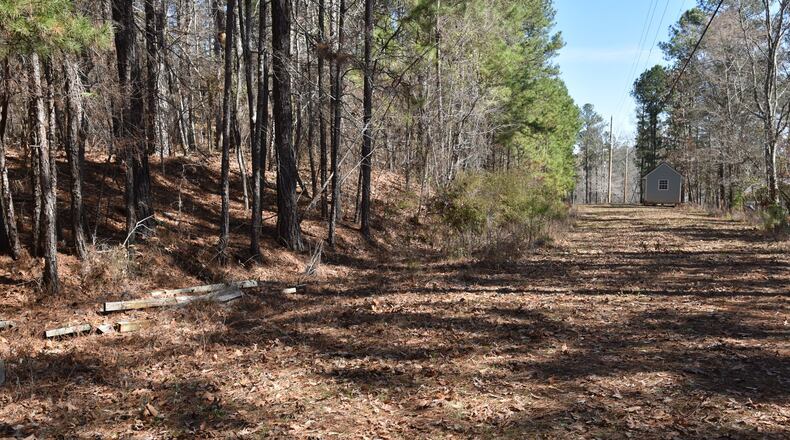LaGrange — For decades, Gene Bowen's family carried a secret from one of the darkest episodes in this mill town's history.
Bowen was 6 on a Sunday morning in September 1940 when his older brother, Uyless, made a chilling discovery. On a dirt road near the family’s farmhouse, the white boy came upon a stranger laying at the edge of a field: a young black man bleeding from multiple bullet wounds.
Bowen’s parents, William and Lucy, hurried outside with a bed sheet, covered the wounded man and rushed him to town. He was unconscious when they arrived at the local hospital. Austin Callaway died that morning.
“I just remember seeing a sheet over somebody,” Bowen, 83, told The Atlanta Journal-Constitution. “They was humble people. They tried to help anybody.”
The night before, an armed group wearing hoods had snatched Callaway from the city jail and driven him to the remote stretch of Troup County where they shot him, leaving him to die alone in the darkness. News of the lynching spread in papers around the country, but the Bowens kept quiet, fearing retaliation from the Ku Klux Klan.
No one was ever prosecuted and as the decades passed, silence helped the bloody episode recede from memory.
This month, Bowen showed an AJC reporter and local residents where Callaway was murdered, revealing the location for the first time. The revelation, and the details of the Bowen family’s attempt to save the dying man, paint a fuller picture of the hushed-up crime.
In LaGrange, a public examination of Callaway’s lynching has sparked a reckoning of the violence committed against black Troup residents during the Jim Crow era, and helped launch a civic movement to make amends.
Saturday, black and white residents of the county gathered to dedicate a historic marker memorializing Callaway’s lynching and three others documented in the area: Willis Hodnett in 1884; Samuel Owensby in 1913 and Henry Gilbert, a Troup County resident who was lynched in neighboring Harris County, in 1947.
Relatives of both Callaway and Gilbert joined clergy and community members at Warren Temple United Methodist Church for the solemn ceremony.
“We’re going to speak these names today, amen,” intoned Deborah Tatum, a family member of Callaway who grew up in LaGrange not knowing the story of his murder. “We speak their names today and from this day forward we will tell the stories to our families.”
The dedication culminated two years of work among black and white citizens seeking racial reconciliation in a place where violence and intimidation against African Americans were never fully acknowledged.
The apology — believed to be the first of its kind — drew worldwide attention to this town 60 miles southwest of Atlanta and shook loose local memories, such as the Bowens'. Some still remember the fear Callaway's brutal killing struck in the black community, and how stories spread about what triggered his murder. There even have been whispers of who may have been involved.
“It’s broken some barriers between the races,” said Ernest Ward, president of the Troup County chapter of the NAACP. “We’re starting to tear down walls that have existed for years.”
Credit: Hyosub Shin
Credit: Hyosub Shin
Seeds of reconciliation
LaGrange today is a flourishing town of 31,000, where the cotton mills of a century ago have been supplanted by auto parts manufacturers supporting the nearby Kia Motors plant. The area is near West Point Lake and Callaway Gardens, top recreation destinations in the state, and the city itself is growing at a time when many small Georgia towns are shrinking.
LaGrange city leaders tout the city’s promising future with some $1 billion in recent corporate investment that will create 2,100 new jobs.
But the rosy outlook conceals a long legacy of racial inequality.
In 2013, Jim Thornton, a white Republican, was elected the 42nd mayor of LaGrange, defeating a black Democrat and continuing an unbroken record of white mayors in a town roughly divided between black and white.
As a city council member, Thornton had heard people talk about racial divisions in the community for years, but felt he’d heard few answers. After he became mayor, Thornton researched racial reconciliation efforts in other communities. He wanted to develop a similar program for LaGrange. Initially, he said, he met resistance because people didn’t know where it would lead.
That changed in August 2014 when the city of Ferguson, Mo., erupted in racial violence over the police shooting of an unarmed black man.
What happened in Ferguson helped convince some LaGrange residents it was time for racial dialogue.
“I was told I was playing with fire,” Thornton said. “I was just tired of ignoring it. I was tired of everyone saying this is an issue and no one wanted to do anything about it. My attitude was this program may not work. It may even fail. But doing nothing was not an answer.”
Credit: Hyosub Shin
Credit: Hyosub Shin
A program to foster dialogue
The city, along with nearby Hogansville and West Point, enlisted Southern Truth and Reconciliation (STAR), an Atlanta-based non-profit that helps communities explore the legacy of racism and violence with hope of improving civic ties. They partnered with Hope in the Cities out of Richmond to develop a training program where leaders and residents held workshops on race and diversity.
“If you don’t structurally do something about these past atrocities the legacy lives on and trips you up with new incidents,” said The Rev. Thee Smith, a religion professor at Emory University and a co-founder of STAR. “The Black Lives Matter movement around police shootings of black men, unarmed black men, is the kind of echo of what happens when you don’t structurally deal with the past.”
More than 200 people have gone through the program and, while no one says racial tensions have disappeared, everyone agrees the communication has fostered better understanding. Chief Dekmar and NAACP president Ward forged a stronger relationship through the program.
The chief, who has led the agency for more than two decades, first learned of the Callaway lynching when a pair of elderly black women meeting with a detective in the department reacted to historic photos of white officers on the wall a few years ago. One whispered to the other: “They killed our people.” When the chief heard the story, he researched the claim and discovered the Callaway case.
He found no records of an investigation but did find a “tone of indifference,” demonstrated by a grand jury that met in 1940 to hear the case. The jurors’ only suggestion in response to lynching a black man from the city jail: Get better locks for the cell doors.
“I owe an apology to the African-American community that has lived with the burning frustration of injustice that was the result of an intentionally indifferent justice system,” he said.
Credit: Hyosub Shin
Credit: Hyosub Shin
Murder in the night
The name Austin Callaway stuck with Joe Weldon for most of his 84 years.
Seven at the time of the lynching, Weldon has never forgotten the unease and anger he saw in his parents as they discussed what happened. Neighbors in their rural LaGrange neighborhood talked about it, too, he remembered.
“It was like a cloud over your head,” Weldon said. “Back then you was scared too — you didn’t know when the white man was going to come in your house. Dad always told us ‘Make sure (you) do not get in trouble because the Ku Klux Klan might come and snatch you out of the house.’”
He recalled how speculation about the lynching boiled at a downtown gathering spot where African American men swapped stories. One story said that Callaway had been walking on a sidewalk and failed to cross the street when a woman passed — a violation of unwritten Jim Crow rules.
Another account said Callaway had been doing yard work for a white family and got cross with the woman of the house when he tried to collect payment. She had promised to pay him cash, but then insisted on paying him in pears.
Officials at the time claimed Callaway, 24, had assaulted a white woman, but no police records exist to verify this claim. All that is known is that he was arrested Saturday, Sept. 7, 1940, and put in the city jail, which was then housed in the basement of City Hall.
That night an armed group of a half dozen white men in masks showed up and took Callaway from the jail at gunpoint. They drove him roughly eight miles from town toward the Liberty Hill Road area, a rural stretch in the vicinity of the Bowen’s home, where the group shot him in the head three times. He was also shot in the arms and hands.
Credit: Hyosub Shin
Credit: Hyosub Shin
‘It happened right back there’
On a recent morning, Gene Bowen returned to the location for the first time in decades with an AJC reporter and members of Troup Together, a bi-racial civic group researching the case.
Time has transformed the area, but it remains rural. The federal government dammed the nearby Chattahoochee River in the early 1970s to create West Point Lake. The road where Callaway was found is no longer used. Years ago, the roadway was moved about a 100 yards north and paved.
“It happened right back there,” Bowen said, pointing to a clearing lined by power lines and pine trees where the dirt road once ran. “I understand he was shot here.”
Bobbie Hart, co-founder of Troup Together, said locating the spot where Callaway spent some of his final hours is significant in helping recover this hidden history.
“I don’t know what Austin experienced, but it must have been horrendous,” said Hart, who is black. “This is a very powerful moment for me. It’s almost like this is a miracle.”
Credit: Hyosub Shin
Credit: Hyosub Shin
Few historic markers about lynchings
In 2015, when a bible study group tried to organize a public commemoration on the 75th anniversary of Callaway’s death, few in the community knew about the lynching. Not yet knowing the precise spot where Callaway had been found, Hart and about a dozen people gathered for a prayer at a nearby church.
Troup Together formed out of that effort. The group is composed of faith-based community members from a variety of ages, backgrounds and professions.
Its members have spent the past 18 months collecting news articles, contemporary documents and whatever else they could find about the case. Their efforts, along with the NAACP, helped Chief Dekmar push ahead with his public apology in January.
“What we hope is just the story of the silence over it can be broken and others can feel like they can come forward and talk about the things that happened,” said Wesley Edwards, a Troup Together co-founder, who is white.
The group partnered with the Equal Justice Initiative (EJI) in Montgomery, Ala., to advance the installation of the historical marker, which EJI paid for with private funds.
Like most Southern states, Georgia's official state marker program has scant mention of lynchings. The program, started in the 1950s, has more than 2,100 markers posted on roadways and property across the state, according to the Georgia Historical Society oversees the program. More than 900 markers relate to the state's Civil War history.
Only four markers are dedicated to specific lynchings, while two others about governors mention their role in the case of Leo Frank, a Jewish man lynched in Marietta in 1915.
EJI is trying to fill the gap in this public history through its marker program and with a lynching memorial and museum slated to open next year in Montgomery. The group believes the public needs a fuller grasp of the legacy of racial terror to properly understand issues of racial inequality and injustice today.
“Part of the reason these problems persist is because of silence,” said Bryan Stevenson, executive director of EJI. “Today we break through the silence. We’re putting up these (markers) because it’s important to speak to this past. There is no reconciliation without truth.”
Credit: Hyosub Shin
Credit: Hyosub Shin
Recognition brings healing
The marker dedicated Saturday now stands in the yard outside Warren Temple United Methodist Church and includes the story of the church’s role in pursuing justice. In 1940, Warren Temple’s pastor, Rev. L.W. Strickland, tried to draw attention to Callaway’s murder by helping organize the first local chapter of the NAACP and holding mass meetings.
But local authorities did nothing.
“They have settled the matter by ignoring it,” Strickland wrote in an October 1940 letter to NAACP lawyer Thurgood Marshall.
The marker paints an unflinching picture of the brutal legacy of racial violence across Georgia and the South from 1877 to 1950. It describes how thousands were lynched across the region and how the victims were often subjected to burning and mutilation, sometimes in front of crowds of thousands of spectators.
The service that preceded the dedication included apologies and confessions by white religious leaders in LaGrange to the families of Callaway, Gilbert and Strickland. It was a powerful expression of remorse and contrition for the failings of past church leaders and their congregations.
Pastor Greg Brown of Western Heights Baptist Church visited the grave of Gilbert last week and said it made him ponder the injustice perpetrated on a man who was a church deacon and respected member of the community.
“We look into the grave and we ask: What kind of people were we? What was in our hearts,” said Brown.
The Rev. Cade Farris of First Baptist Church, a prominent white church on the square in LaGrange, apologized on behalf of those who knew what was happening in society seven decades ago, knew it was wrong but said nothing. He also acknowledged others who carried out acts of terror had ties to white churches in the community.
“I want to apologize on behalf of those that filtered into churches in Troup County on Sunday hearing God’s word, and during the week committing hatred, terror — God have mercy,” he said.
Georgia had some 600 reported lynchings — the second highest total of any state. Roughly 90 percent of the victims were black. One of them was Henry Gilbert.
Gilbert, a husband and father of four daughters, was a successful farmer who owned 111 acres in Troup County. After a black man, Gus Davidson, allegedly shot and killed a white farmer during a dispute over the farmer’s dead calf, Davidson fled the area.
A mob of white men terrorized the black community that evening in search of Davidson, according to a July 2016 report about the case by law students at Northeastern University in Boston. Nearly three weeks after the killing, Gilbert was arrested at his home in the middle of the night. The authorities falsely claimed he helped Davidson escape.
Within a few days, Gilbert was dead. The police chief in Harris County, Willie Buchanan, shot him five times in the local jail, claiming self-defense. The evidence suggested that the chief’s claim wasn’t credible. In addition to the gunshots, witnesses said Gilbert’s face was disfigured and his body badly mangled, the Northeastern report said.
“The n——- drew a chair on me and I had to kill him,” the chief later told a reporter.
Gilbert’s wife and children were forced to sell the farm after his death and fled the area. They initially moved to Atlanta, before some of the family moved to the Upper Midwest. His descendants, some of whom just learned about the lynching in the past year, returned to LaGrange to honor their grandfather on Saturday.
Sheila Moss-Brown, who learned of the lynching about a year ago when the law students contacted her family, is from Chicago. The 51-year-old said knowing the story of Gilbert’s lynching made her angry, but helped her gain new respect and love for her mother who never expressed anger or hatred toward whites.
“I was just in amazement that my mother as well as her sisters and my grandmother were able… to live through that and continue to live holding this in their heart and their spirit,” she said.
Journalist finds family ties to lynching
Decades after Gilbert’s death, Karen Branan discovered that her Georgia family had a connection to his killing. Her grandfather, Douglas Hadley, was the Harris County sheriff and his name is on the warrant for Gilbert’s arrest. She believes her grandfather lied to the FBI to help cover-up the actions of the chief, who was his friend.
Branan, a journalist, mentioned the connection in a book in which she investigated her family's ties to a 1912 lynching.
Since publication, Branan has met several members of Gilbert’s family and apologized to them.
“I don’t believe these hidden stories are ever truly hidden,” she said. “I always sensed that something very dark regarding race had happened in my family.”
For Moss-Brown, revelations about how her grandfather died have personalized the history of lynchings, she said. It hurts her to think of him held behind bars for days, knowing he would likely never see his wife or daughters again.
She said she’s appreciative of the students’ efforts and is thankful for the truth about what happened, even though it came decades later. She said so many lies had been told about her grandfather at the time.
“This is an amazing first step to recognize the wrongs that were done and recognize them by name,” she said. “But I think about so many families that don’t know what happened to their family members.”
About the Author
Keep Reading
The Latest
Featured











